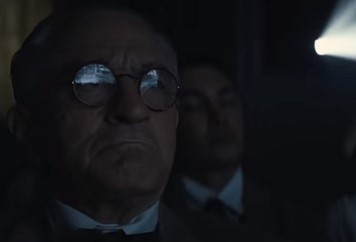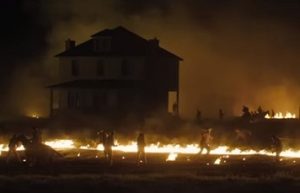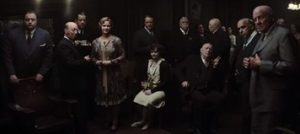Movies talk to each other. What did the films of 2023 have to say? This is a look at how two movies from the past year tackle similar subjects in different ways. Be warned: SPOILERS for Killers Of The Flower Moon and Skinamarink follow.
You can’t move. You see things and sometimes they make sense and sometimes they don’t, you have to find meaning from unrelated images. They can be enticing and confusing and, when you are at your most vulnerable, something more than scary. Dreadful. Despairing. You are at the movies. You are having a nightmare.
A nightmare is more than discomfort. When I saw The Irishman in the theater four years ago, I couldn’t make it through without a pause for relief. Sometime after the mob iced Bad-Back Jack I had to run off to the restroom, hoping I wouldn’t miss anything before I returned. Three hours and twenty-nine minutes is a long time! Killers Of The Flower Moon is three minutes shorter but this time at the theater I was able to sit through the screening without a break. Martin Scorsese got some flack for not putting intermissions in his most recent movies and for what it’s worth, I don’t think he would begrudge anyone needing to take a piss during them. But he and his collaborators are structuring these films without clear and codified breaks on purpose. In The Irishman, it’s to sweep us along with Robert DeNiro’s life, one thing after another until the next thing is a betrayal and the thing after that is isolation and the last thing anyone ever gets is coming, the weight of all those other things shoving you toward it with a clarity too terrible to acknowledge. In Killers, Scorsese is aiming for immersion in something less coherent but no less inescapable, and he’s not going to provide any way out.

The facts are all there in David Grann’s book of the same name. The Osage Nation found massive oil deposits on their Oklahoma reservation land in the early 20th century and the surrounding white residents schemed to control their money and murder the Osage for their land, sometimes after marrying them first. The history of cattle baron and plot orchestrator William King Hale, his dissolute nephew Ernest Burkhart and Burkhart’s Osage wife Mollie Kyle – who Burkhart slowly poisoned on Hale’s orders – is in court proceedings and news articles, although it is incomplete even there and downplayed in history books even now. The structure of Scorsese’s movie is chronological, like many a history, but its style is not dry recitation. Jack Fisk’s production recreates the Osage world and the details of a wedding dress, a bottle of whiskey, a doctor’s office, accumulate in Thelma Schoonmaker’s relentless but not frenetic editing, detritus in a passage of time that rarely shows specific dates but becomes defined by death and loss and the insistent doom of Robbie Robertson’s score. To watch it is to be trapped in it.
And while trapped, continue watching. Lily Gladstone’s Mollie and other Osage try to stop the increasingly obvious killings, looking for help from the local law (corrupt), private investigators (beaten and dissuaded), the federal government (uninterested for years and even when they are investigating, taking their sweet time) and seeing no results. Action divorced from consequence, flailing to no effect, the dreamer’s inability to change their circumstances. Mollie also has bad dreams, seeing owls of ill omen. And why would she not — she repeatedly allows Ernest to inject her with medicine and it turns out that medicine is actually poison, keeping her trapped and often insensible. At one point she writhes in agony in Hale’s mansion as Hale’s men set fire to the land outside, it’s some kind of insurance scheme and it looks like hell on earth, a nightmare for us in the audience to watch while Mollie lives her own horrible dream existence. Letting someone she trusts continue to feed her something that is tearing her apart.

Mollie is not exactly an audience surrogate, though. Leonardo DiCaprio’s Ernest is the main character, a very stupid man who is cunning enough to rely on his stupidity as an excuse to both others and himself, letting himself be led into a plot to poison his wife and bomb his sister-in-law and dismantle an entire nation because his uncle told him to. Both DiCaprio and Robert DeNiro as King Hale are longtime Scorsese collaborators and their presences play off their older roles, adding to the uncanny nightmare feel. DiCaprio has been naive (Gangs of New York) and a hugely destructive asshole (Wolf of Wall Street) and a man trapped by the machinations of the powerful (The Departed), all of these things are present in Ernest but DiCaprio does not deploy his usual charisma or intensity. He’s a dipshit with no real problems who throws away the love he is lucky enough to share; while the movie is ambiguous about how much Ernest knows about his murderous actions it is clear that he actually does love Mollie and she loves him back, making his betrayal its own open wound. DeNiro has an even longer history of ringing changes on unsavory masculinity for Scorsese but he’s never before been as satanic or bureaucratic in his evil, neither tortured or righteous but casually just taking what he wants.
Scorsese has long been fascinated by destruction and desire, finding the pleasure points and thrills of sin and enjoying them even as he knows they are bad; this is best expressed in how darkly funny he finds his awful men. But in Killers he restages images and sequences in off-putting ways, things that seem familiar are now sour and unsettling, like a bad dream. This comes through most strongly in the botched assassination of William Belleau, Mollie’s first husband and an obstacle in the way of Hale and his cronies obtaining her land — the hired killer fucks up what is supposed to look like a suicide attempt and he and Ernest yell it out with each other, each trying to shift blame and fearing Hale’s wrath. Their stupidity and ass-covering over a brutal death has the rough outline of the Billy Batts killing in Goodfellas but it is completely drained of that sequence’s dark humor. Henry Hill and company are worried about incurring the wrath of their fellow mobsters but also have to deal with the basic illegality of their crime; the only concern in Killers is how an obvious murder will void a land deal, not lead to justice being served.
Toward the end of the movie, when Ernest has finally been caught by the feds and is thinking of turning on his uncle to get a lighter sentence for himself, he is led into a room containing every white person in town who is anyone, all of the movers and shakers and pillars of the community, here to convince him not to squeal. It is lit and shot like a horror movie in its evocation of the powerful and elevated existing in realms outside mortal comprehension and echoes the New World aristocrats of The Age Of Innocence. But those people were blue bloods using class and wealth as distinction between fellow white people in a cruel game where everyone knew the stakes, in Killers they are aligned against the natives in a position of genetic if not divine right — arrivistes on the land who have assumed ownership, and why not? Who will stop them? Scorsese has spent decades dramatizing struggle — man vs. self, man vs. man, man vs. society — and while the trappings of crime and passion that define his conflicts are present in Killers there is no struggle here, just slow suffocation.

Killers Of The Flower Moon creates a world and then agonizingly and remorselessly winnows it down, but even in its purposefully painful story it is still pop culture, not a textbook. That complete recreation of a lost time, the tightening noose of Scorsese and Eric Roth’s script, the performances that reveal characters in squints and stares (and the remarkable supporting cast of distinct faces, from Native actors like Tantoo Cardinal and Cara Jade Michaels to wary musician/thespians like Jason Isbell and Sturgil Simpson to the perfectly glazed ham of Jon Lithgow and Brendan Fraser) — this is still a mainstream movie designed for a mainstream audience, and you don’t make a three-and-a-half-hour movie for that audience without knowing how to keep it entertained. The contradiction in this is laid out in the movie’s epilogue, where Scorsese himself appears in a radio dramatization of the Osage murders years after the fact, after a few people got punished but no real justice was served. When no one in power truly acknowledged and tried to redress the genocide committed by one nation against another. The dramatization is the movie in miniature, it is a technically marvelous piece of work (the sound effects are very cool to see in action) that is shaping an atrocity for the amusement of a paying audience. Amuse, Merriam-Webster says, “to entertain or occupy in a light, playful, or pleasant manner,” and by using the radio here Scorsese is not just limiting his critique to his one movie or movies on the whole but entertainment in general, the entertainments that he has spent his whole life watching and absorbing and creating. The archaic definition of amuse, according to M-W, is “to divert the attention of so as to deceive.” A dream that lies, and always intends to.
It’s not that Scorsese does not care about these matters, he truly does; it’s just that he couldn’t not be entertaining if he tried. But the mainstream is not the only way to dream. Kyle Edward Ball made Skinamarink in a week on a budget of $15,000, it wound up with a theatrical release after a pirated leak and word-of-mouth buzz but it is still very much a backyard movie in production and an aggressively uncommercial film in style and subject matter. Ball created the movie after running a YouTube channel where commenters would share their nightmares and he would create short filmed versions. Here he takes the story of a four-year-old boy and six-year-old girl trapped in a house with a demon that can move things with its mind and whose disembodied voices tells children to do terrible things and stretches it into 100 minutes of bad dream.

Where Scorsese finds nightmarish horror in clear action and unanswered consequence, Ball obfuscates. We know the names of children Kaylee and Kevin and that something may have happened to their mom that their dad isn’t talking about; we know they have a bunch of Legos and a VHS tape of public domain cartoons; and we become very intimate with certain rooms and hallways in their house. But soon both parents disappear, as do the exterior doors and windows and toilet, for no apparent reason. Day and night have no meaning, the flickering TV is the most consistent source of light. Chairs and dolls are pinned to the ceiling by an unknown force, and the children communicate in confused and uneasy whispers before Kaylee abruptly exits the picture. Then it’s just Kevin and the low voice that has been calling to the children, and things become really untethered.
The above summary is vague but fairly easy to follow in text form. How Ball conveys his dream magnifies its discomfort. Ball added visual noise to his digital filmmaking to replicate the fuzziness of a 90s camcorder, in one of the very few moments of clarity, at the beginning we are told the film takes place in 1995. I’ve seen criticism that it doesn’t accurately depict that VHS look but what it does convey is something I haven’t really seen in a movie before, the dense and blurry darkness I see in my house when I’ve taken off my glasses to go to bed, a smog that doesn’t conceal as much as potentially contain things. It warns against but also demands further looking. And Ball’s camera placement also encourages contemplation, because he frequently uses lengthy static shots from low and tilted angles, as if from a dropped or discarded toy. When the camera does move, it is in slow pans and zooms that also do not indicate a distinct perspective – unless it may be the demon’s. The use of movement is Ball’s real coup de cauchemar, because with a very few exceptions — a child’s legs, a turned head — he never shows his characters acting or reacting, even partly in the frame. The most visually dynamic thing the viewer sees are those old cartoons.

And while we see objects moved, like Legos stuck to walls and toilets vanished and blood in spatters on the floor, Ball portrays this in blink cuts of shifted position, after some early scenes of relative normalcy movement itself is almost entirely elided. We can hear things moving around, including the kids tiptoeing through their house, but not see them because our perspective is forced elsewhere. If Scorsese’s nightmare ties the audience to characters who cannot escape, Ball’s nightmare traps its watchers in a state of powerlessness. That menacing and fuzzy dark is a matter of being unable to see, the camerawork is a decision to not allow us to see and it is what creates that sense of being a simultaneous participant and observer that is common in so many dreams. We are stuck in the house with the children, but we can’t process them as characters that we can identify with and then cathartically deal with the fear through. They can act and we can’t; we can’t see what they can and are often only able to listen. Ball uses subtitles to convey dialogue that is spoken too low or indistinct, sometimes from the children but more frequently from the demon, and it has a similar disturbing double effect — subtitles of clarification (as opposed to translation, like the Osage language in Killers) are a reification, an interjection that you really did hear something. That voice really did tell you to put a knife in your eye. What could throw the viewer out of the movie embeds them deeper; just because you know you’re in a dream doesn’t always mean you wake up.
All of this creates an atmosphere so full of dread then when Ball does shift to something approaching a more conventional horror style, the tension becomes unbearable. At a few points, Bell strays from his steady pans and static shots for a moving camera that is clearly the point of view of Kaylee or Kevin, climbing or descending stairs and following the illuminations of a flashlight and being led to things that are terrifying to see. One of these follows Kevin into the basement where he discovers Kaylee, mouth and eyes erased by the demon, it is a damn good jump scare (and even here Ball maintains his motionless motif, Kaylee has been turned into an object and we only see her blank face as a static object). But even creepier is an earlier sequence, where the demonic voice tells Kaylee to come upstairs and she sees her father — motionless, of course, and face turned away — sitting on his bed. He tells her to look under the bed and of course she does and so do we, we are seeing through her eyes, stuck with her movements even though this is obviously a terrible idea. Nothing is under the bed but that roiling dark. And when Kaylee stands up, her father is gone and now her long-absent mother is on the bed, on the other side and also motionless and looking away. And she also tells Kaylee to look under the bed. It is an incredibly potent mix of helplessness — no explanations, no stability, no way for the viewer to not obey barring turning the movie off — that the rest of the movie stretches out but is condensed here to pure oneiric horror.

At least one person has found a political aspect to Skinamarink, but it’s easier to see metaphors for and allusions to domestic abuse. Late in the movie Kevin calls 911 and actually gets an operator, who seems to be following the right script for getting a whispered call from a four-year-old — making sure he’s safe, trying to keep him on the line without panicking him, being calm but probing for whatever information they can get. “Are you whispering because someone is there with you?” the operator asks, but this isn’t the right question. Something is there, but also nothing is here but Kevin and a house that no longer conforms to reality. In Reverse Shot, Natalie Marin digs into the angle of abuse and its effects, how the movie creates “a dissociative haze of subject and perspective—children displaced within their own home.” And lost in time. A card reading “572 Days” appears toward the movie’s end, as detritus piles up in the house. Blood stains and screams appear, then disappear, then appear again. Is everything happening over and over in a loop, or in an endless progression? And does that matter? In any case, the nightmare doesn’t end. Ball pulls back in this final rush of images, showing the house itself in a void. Even if Kevin could leave, there is nowhere to go. He asks for the name of his tormenter and gets no response. The last thing it tells him: Go to sleep.
In Stephen King’s essential horror survey Danse Macabre, he quotes a letter from Harlan Ellison discussing the permeable borders of fantasy, with Ellison at one point describing how Ayatollah Khomeni managed to alter reality with his revolution: “He has dreamed, and forced the rest of the world to live in that dream. That it is a nightmare for the rest of us is of no concern to the dreamer.” That may describe the demon of Skinamarink but I don’t think it sums up Scorsese’s realization at the end of Killers of how he fits into the American Dream and how that dream is really a nightmare. The look in his eye and tremor in his voice are those of a man trapped in his dream, seeing the cost of what he has done and enjoyed, and how the entertainment he makes keeps the dream alive. But he does not get the final word. The movie begins with the Osage at the turn of the century mourning their coming assimilation and destruction, the last shot leaves Scorsese behind and cuts to an overhead shot of the Osage in the present day, gathered for a powwow dance. Instead of impeccable replicas of the past, the Osage are carrying lawn chairs, sturdy and functional. The drums’ thump is at the same pace as the ominous rhythm that suffused the movie until now, but it feels more purposeful, the beats hitting harder and then picking up speed as the shot pulls back while the Osage dance. It doesn’t show a void or a nightmare but a people that are still alive and awake.


